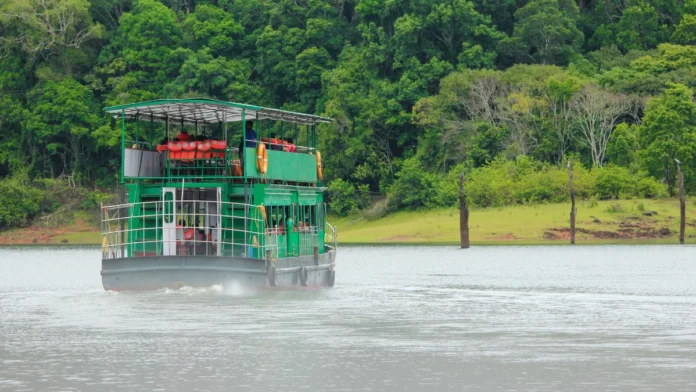Kerala, a beautiful state in southern India, is famous for its national parks, with Periyar National Park being one of the largest parks in the region. The PNP, as it is often known, is classified as a National Park (NP) under Category II of the International Union for Conservation of Nature (IUCN). This designation highlights the park’s role as more than just a tourist destination, highlighting its major function as a conservation area committed to the conservation of diverse flora and animals.
Every year, lakhs and thousands of people visit the Periyar National Park, which is maintained by the Kerala Forest and Wildlife Department. This national park, which shares its border with Tamil Nadu, is located near the southernmost tip of the Western Ghats.
Periyar National Park History
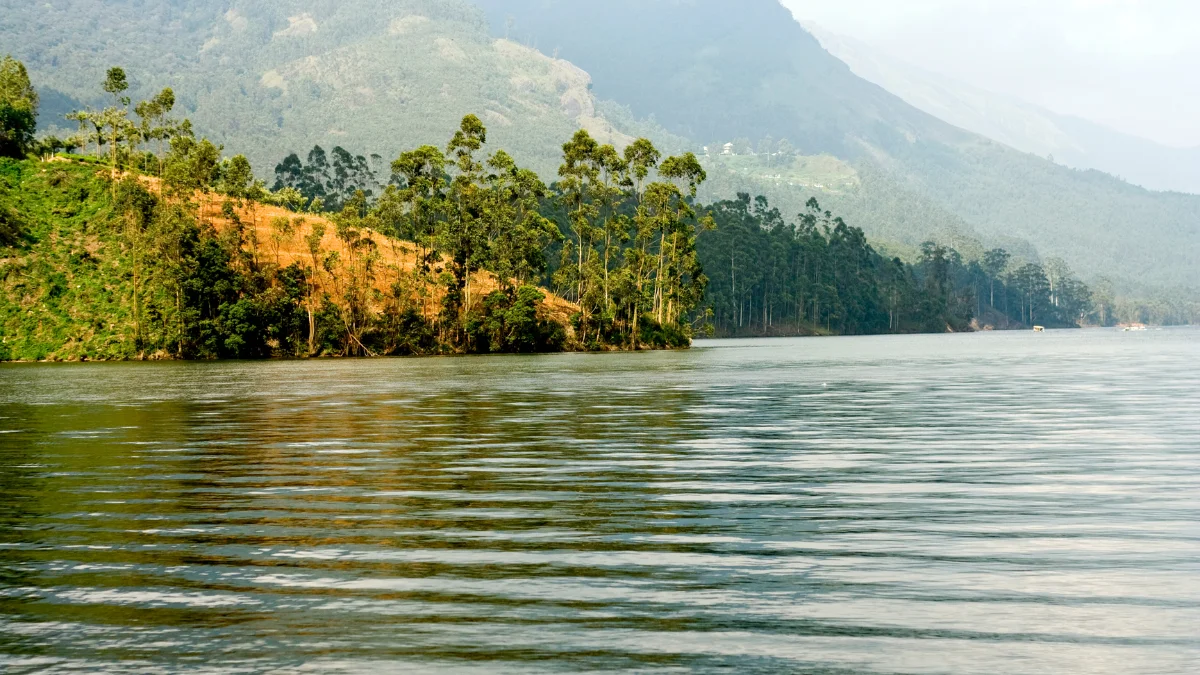
Periyar National Park & Wildlife Sanctuary was founded in 1982, although its history dates back to the late 1800s. The Periyar Lake Reserve was established in 1899 as a result of the Mullaperiyar Dam being built in 1895, which laid the groundwork for the sanctuary.
In 1934, the forest that surrounded Periyar Lake was declared a private wildlife reserve by Chithira Thirunal Balarama Varma, who was the Maharaja of Travancore at the time. This calculated action was taken to prevent owners of tea plantations from invading the area, which threatened the rich environment needed for their farming. Predating India’s independence, this was the first game reserve, known as Nellikkampatty Game Reserve.
After the country gained independence in 1950 and political stability spread throughout the country, the Periyar property was combined and formally designated as a wildlife sanctuary. In an effort to save the tiger population in this area, Periyar was designated as a tiger reserve in 1978. The crowning achievement came in 1982 when the central forest region was granted the esteemed designation of a national park, so cementing its position in biodiversity and wildlife preservation.
A significant financial milestone was reached in 1991 with the launch of Project Elephant, which aimed to conserve Asian elephants in the national park. In 2001, more organisational changes took place that led to the park’s separation into Periyar East and Periyar West. The Goodrical Range was expanded further in 2007 when 148 square km were added to the park. The reserve was strengthened in 2012 when 148 square kilometres of the Ponnambalamedu evergreen forest were added, strengthening its dedication to protecting the rich natural legacy.
Flora at Periyar National Park
The habitat of Periyar National Park & Wildlife Sanctuary is diversified and includes alpine grasslands, savannas, artificial eucalyptus stands, wetlands, and lake and river ecosystems in addition to tropical evergreen, semi-evergreen, and moist deciduous forests. With a total of 1965 taxa (species and infraspecific) of flowering plants that have been identified, the park displays an abundant botanical tapestry, with 17 species being designated as “possibly extinct.” Of them, 140 kinds of orchids and 171 types of grass grow well in the park’s diverse ecosystems.
Numerous types of grasses, including thick grasses like elephant grass and flora resistant to fire, may be found in open grasslands near water sources and in montane settings. Herbivores that graze in these habitats include wild boar, gaurs, Asian elephants, and sambar.
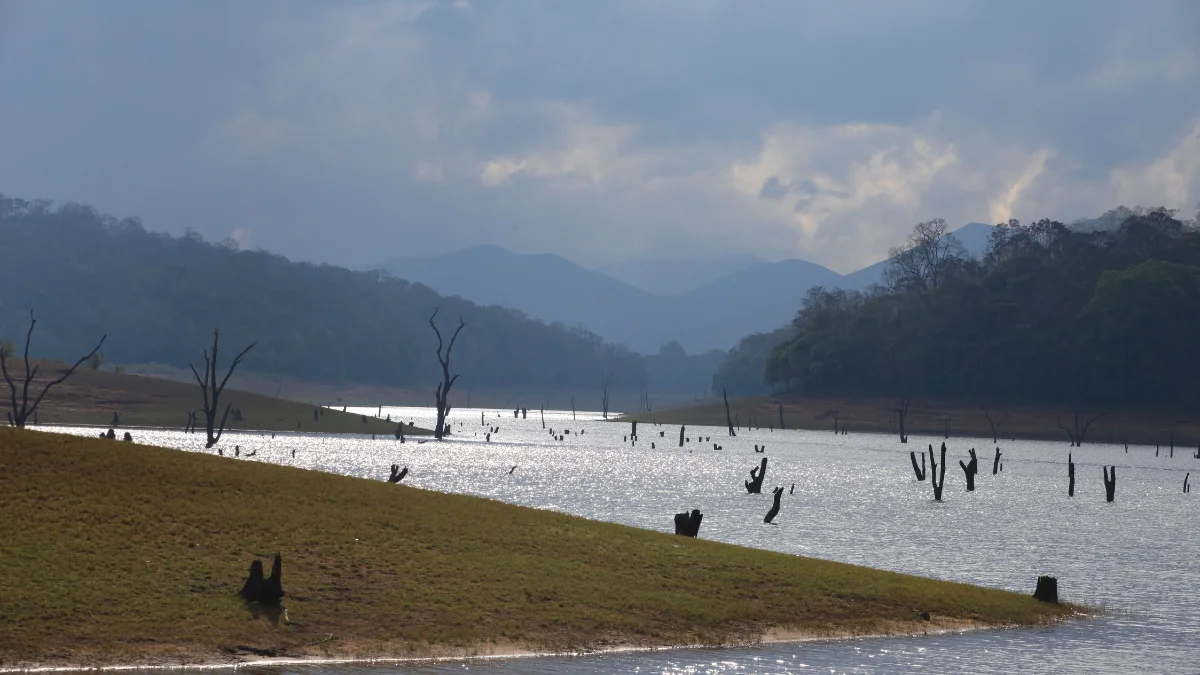
A variety of trees, including teak, rosewoods, Terminalia, sandalwoods, mangoes, jamun, tamarind, banyans, sacred fig, kino tree, bamboo, Diospyros bourdillonii, Hopea parviflora, Dipterocarpus indicus, Semecarpus travancorica, and the unusual south Indian conifer, Nageia wallichiana, can be found in the park’s varied forests. The flourishing of the medicinal gloriosa lily further enhances the park’s ecological value. Notable indigenous plants, including Syzygium periyarense and Habenaria periyarensis, enhance the park’s biodiversity.
The park survives as an island of great biodiversity among human agriculture, surrounded by agricultural landscapes that include tea, cardamom, and coffee plantations. This highlights the significance of conservation efforts in this ecologically valuable region.
Fauna at Periyar National Park
Tucked away in the Western Ghats, Periyar National Park is home to a variety of animals. The Asian elephant, which thrives in the sanctuary’s vast ecosystems, is one of its most famous residents. Periyar is even more alluring when one witnesses these gentle giants, who are frequently spotted bathing and feeding. While sambar deer and wild boars graze in the verdant forests, gaur, or Indian bison, prowl the plains, adding to the complex web of relationships between predators and prey. A tiger reserve was established as a result of the park’s dedication to tiger conservation, with the goal of safeguarding the rare Bengal tigers that live in Periyar.
With the melodious sounds of the Great Hornbill and Malabar Grey Hornbill resonating through the canopy, Periyar’s bird kingdom is equally remarkable. The park’s varied wildlife is enhanced by the lively movements of darters, cormorants, and egrets as they gracefully navigate the lakes and rivers. Kingfishers are frequently seen close to bodies of water because of their colourful plumage. The wide variety of bird life seen in the sanctuary emphasises how essential its aquatic and wetland habitats are to the survival of both resident and migratory species.
The inhabitants of Periyar, who are amphibians and reptiles, complete the biological mosaic. Cobras and vipers are among the snake species that coexist alongside Indian monitor lizards, which frequently bask on rocks. A multitude of frog species that flourish in the many microhabitats of the sanctuary serve as a testament to the Western Ghats’ reputation for amphibian diversity. Guided expeditions by boat or on foot provide tourists an opportunity to see this amazing species coexisting peacefully in the magical Periyar forest.
Things to Do at Periyar National Park
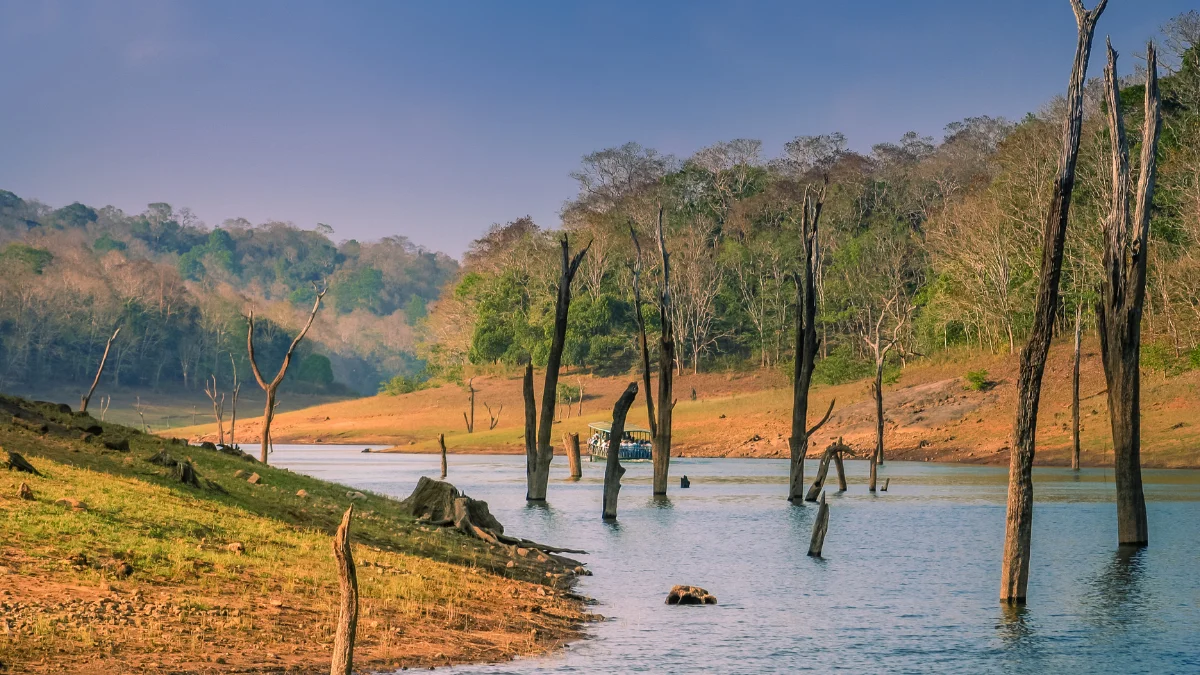
· When visiting Periyar National Park, nature lovers can take safari trips that are customised at various times of the day. Early morning safaris provide an excellent chance for birdwatching, as birds are more active as they forage for food. On the other hand, hot afternoon safaris reveal the presence of famous animals like tigers and elephants when they come out of hiding to cool down or drink from the park’s water sources.
· A night safari offers a rare opportunity for individuals who want to explore at night to see elusive animals like owls and leopards, who are more active in the dark.
· A picturesque boat ride around the famous Periyar Lake, located in the centre of the national park, lasts for one and a half hours. By taking it slowly, you may see the park from a different angle and catch a glimpse of the animals who visit the lake every day to drink. Boating in the afternoon is best for seeing a variety of animals while boating first thing in the morning is best for seeing a lot of water birds.
· With more than 160 species, including the magnificent swallowtail southern birdwing, the biggest butterfly in India, the park is a butterfly lover’s paradise. Other noteworthy species are the lime butterfly, the Malabar tree nymph, and the endangered Travancore evening brown.
· Periyar National Park is home to a wide variety of insects in addition to butterflies, including the rare saturniid Atlas moth and the Asian emerald dragonfly.
· Enthusiasts of amphibians may expect to see a variety of toads, frogs, and caecilians, such as the Asian Toad, the bicoloured Malabar frog, the Malabar Hills fungoid frog, and the Malabar gliding frog.
· About forty different kinds of fish may be found in the rivers and lakes of Periyar National Park, including the indigenous Periyar barb and Periyar trout.
· There are forty-five different kinds of reptiles living in the park, including poisonous snakes like the striped coral snake, king cobra, and Malabar pit viper.
· 35 different animal species may be found in Periyar, including sloth bears, tigers, elephants, gaurs, and langurs.
· Declared a tiger reserve, Periyar is home to 35 Bengal tigers out of the total known tigers. White tigers are also found there.
· With 266 native and migratory bird species, birdwatchers may enjoy a wealth of avian species. The Brahminy kite, great hornbill, Oriental darter, and Eurasian woodcock are among the highlights.
· The park’s avian variety is enhanced by endemic bird species, which provide birders with an exceptional and fulfilling experience. These species include the Nilgiri wood pigeon, blue-winged parakeet, crimson-backed sunbird, white-bellied blue flycatcher, and Malabar grey hornbill.
Periyar National Park Timings and Entry Fees
Being one of the few national parks in India that is open all year round, Periyar National Park & Wildlife Sanctuary stands out. Every day of the week from 6 AM to 7 PM, visitors and naturalists are welcome to enter the park. The best times to see wildlife are at dawn and sunset, while afternoons are better for observing bigger species, especially the elusive big cats. The timing of visits may have a huge impact on wildlife sightings. The sanctuary also arranges night safaris after 8 PM for those looking for a deeper nocturnal experience. These safaris provide the chance to witness nighttime animals like owls and the elusive leopard.
There are several entrance prices for Periyar National Park according to your age, nationality, and the equipment you bring. Adult Indians must pay INR 45, while minors must pay INR 15. Foreign children must pay INR 180 apiece, while foreign adults can enter for INR 500. There are additional costs associated with cameras: still cameras cost INR 38, and video cameras cost INR 300. It is recommended that visitors bring binoculars to enhance their wildlife-watching experience. Rental binoculars cost INR 50 and need an extra INR 100 as a security deposit.
Special safaris and hikes are available in Periyar National Park for individuals looking for more immersive experiences. Priced at INR 150 for those over 11 and INR 50 for those under 11, the boat safari is suitable for a range of age groups. Adventure seekers may experience the Periyar Tiger Trails Trek, which offers a special chance to journey into the heart of the sanctuary’s wildness. The trek is priced at INR 5,500 per person each night, with a discounted cost of INR 7,500 per person for a two-night ticket.
Places Worth Visiting near Periyar National Park
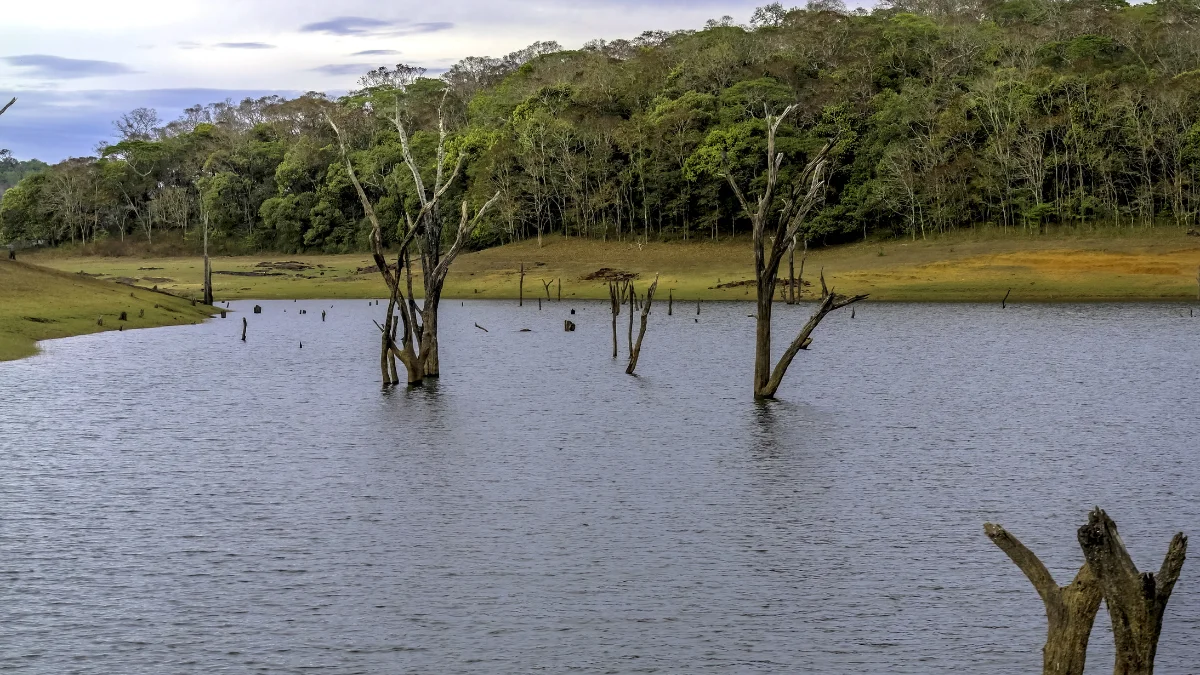
1. Periyar Lake: Located deep within the national park, the 26-square-kilometre Periyar Lake was formed in 1895 by the construction of the Mullaperiyar Dam. The 90-minute boat journey offers a tranquil boating experience, a distinctive viewpoint of the park’s landscapes, and a great chance to see aquatic birds. Throughout the day, boating activities begin at certain intervals. Adult tickets cost INR 225, while children’s tickets cost INR 75.
2. Thekkady: Encircled by the Cardamom Hills and Pandalam Hills, Thekkady is a quaint village located within a minute’s drive from Periyar National Park. Thekkady is well-known for its spice farms, especially those growing cardamom. It also has beautiful lakes and verdant highlands. The town’s well-maintained gardens and spice farms, which welcome exploration, make it a hub for spice lovers in addition to being a well-liked tourist destination.
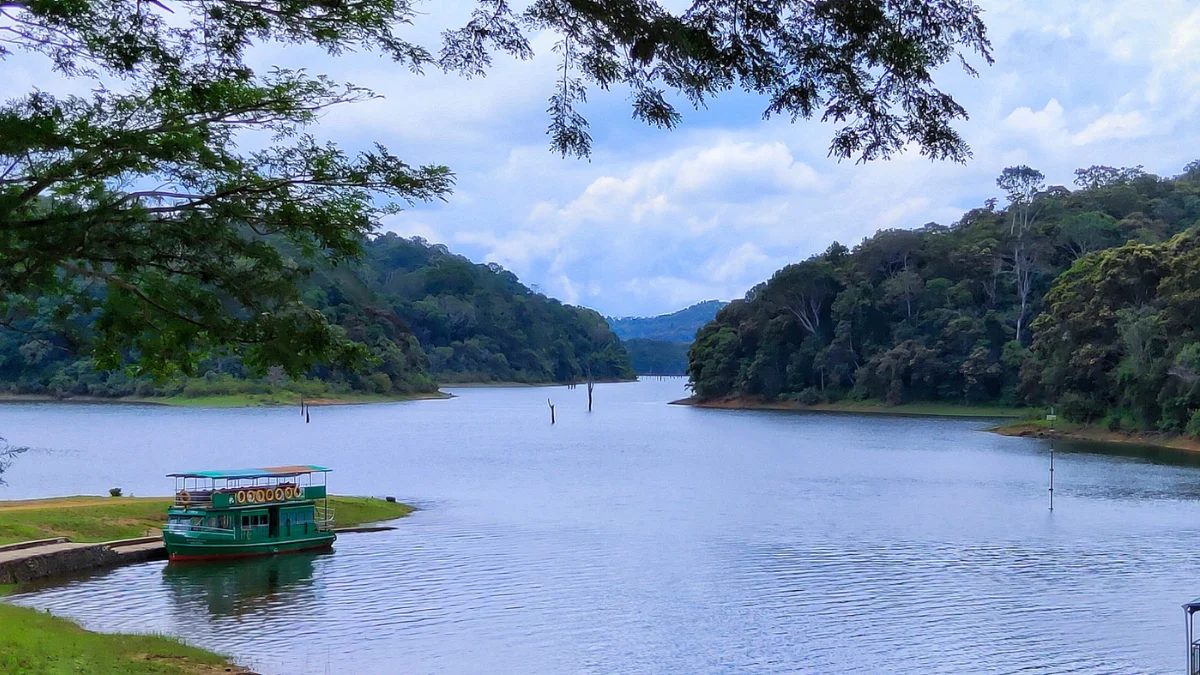
3. Sabarimala: The Sabarimala temple complex, devoted to Ayyappan, is a well-known Hindu pilgrimage site located inside the Periyar Tiger Reserve. Situated between hills and thick forests, the temple receives a lot of traffic during religious celebrations and provides followers with amazing views of the neighbouring highlands.
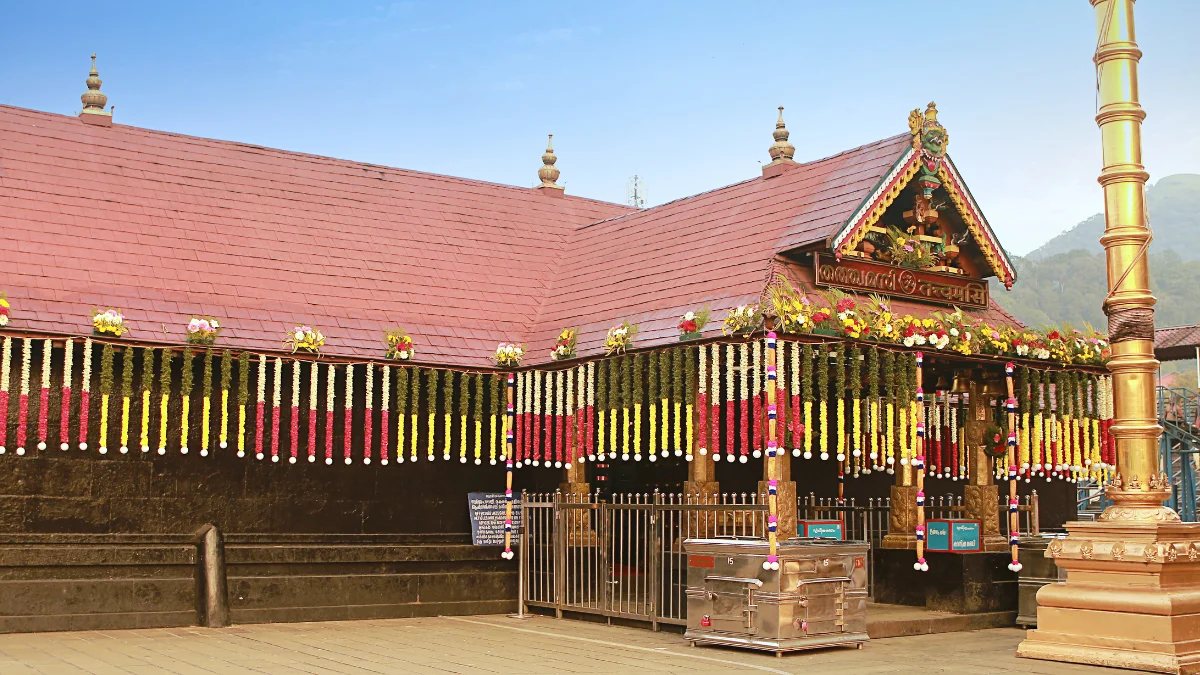
4. Mullaperiyar Dam: Constructed above the Periyar River, the Mullaperiyar Dam is a beloved picnic place and an impressive display of stonemasonry. The gravity-type dam, which is 1,200 feet long and 138 feet wide, has 13 chute spillways that can process 4,518 cubic yards of water per second. A reservoir created by the dam can hold up to 443,230,000 cubic metres of water.
5. Mangala Devi Kannagi Temple: Situated around 10 miles away from the wildlife reserve, this historic Hindu temple is 1,337 metres above sea level. The temple, which is only open to visitors during the Chitra Pournami celebration, is thought to have been constructed more than 2,000 years ago by Cheran Chenguttuvan, the erstwhile monarch of the Tamilakam district.
6. Suruli Falls: Despite being more than 50 kilometres from the national park, Suruli Falls is a fascinating location that takes two hours to get to. The Suruli River provides the falls’ 150-foot-tall cascade, which is divided into two stages. Encircled by the magnificent Meghamalai mountain range, this site is truly lovely.
7. Parunthumpara Hill View Point: Drive 15 km (around an hour) via NH 183A to Parunthumpara, which is renowned for its stunning hilltop outlook. The place, which lies in the Idukki area, has expansive vistas of misty mountains, lush valleys, and tumbling waterfalls. Hiring an off-road jeep or going for a stroll along the blocked promenade are two ways that visitors may take in the surroundings.
8. Thekkady Rose Park: Thekkady Rose Park, a botanical garden with a concentration on roses and other floral plants, is only 5 kilometres away from the national park. The cost of admission is INR 50 per person, and a family can purchase an Adventure Package for INR 400. In addition to spring bouncing, boating, bungee jumping, and rope walking, the park includes family-friendly attractions that are beautifully installed and ideal for making memories.
9. Kakki Reservoir: Kakki Reservoir is situated inside the Ranni Reserve Forest and is about a 15-minute drive from Periyar Reserve. This reservoir, a Kakki tributary of the River Pamba, was created by the building of the Anathode and Kakki dams. The lake is a great place for picnics and trips since it provides a serene environment surrounded by beautiful vegetation.
How to Reach Periyar National Park

By Flights:
About 150 kilometres distant, Madurai, Tamil Nadu, is the closest airport to Periyar National Park. It takes about four hours to get from Madurai Airport to the park. Alternatively, Cochin International Airport is around 170 km distant, necessitating a driving trip of more than 4 and a half hours if flying into Kerala is more convenient.
By Rail:
At a distance of more than 100 miles, Kottayam is the closest train station to Periyar National Park. It takes around three hours to go by car from Kottayam to the park. India’s vast rail system is reachable from throughout the nation and offers choices for different train travel classes, such as air-conditioned cabins, non-air-conditioned coaches, and the budget-friendly unreserved coach.
By Road:
Taking a vehicle ride is one of the most straightforward ways to get to Periyar National Park. For a smooth and enjoyable trip to the forest, reserve a roomy SUV or a taxi from reliable car rental businesses in Kerala. This form of transportation removes the necessity for several different means of transportation and gives you the freedom to make customised stops along the way, such as rest stops, food stops, or even overnight stays if you’re travelling from a far-off place in the nation.

Best Time to Visit Periyar National Park
The winter months of October through February are the ideal times to explore Periyar National Park. The weather is nice and cool during this time of year, which is perfect for outdoor activities and seeing animals. During these months, the temperature fluctuates between 15°C and 30°C.
Conclusion
Visit Periyar National Park and have a great time. It is one of the greatest wildlife sanctuaries in India that you must visit!


